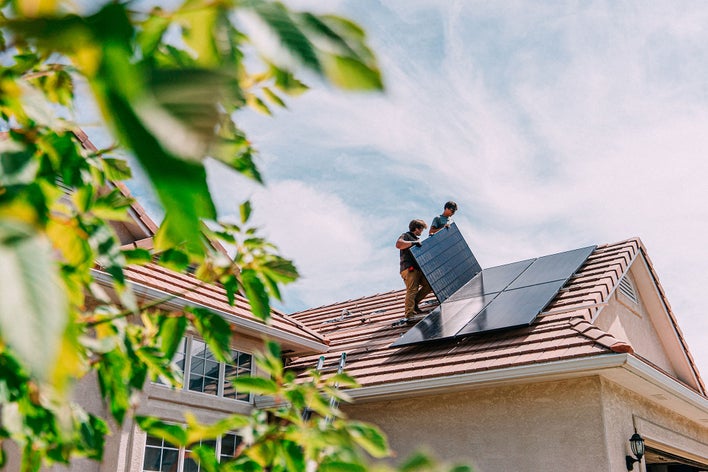8 Ways to Reduce Carbon Footprint: Eco Living Tips

Our world is a beautiful place – and the only one like it that we know of. It’s up to all of us to do our parts to protect the environment and minimize waste, whether that means following some broader eco-friendly strategies, like vacationing closer to home, or taking steps in the house to reduce carbon emissions.
It can be tricky to know the best ways to reduce your carbon footprint at home, especially if you’re new to eco-friendly living. Today, let’s break down seven ways to lower your carbon emissions throughout your household.
What is a carbon footprint?

Before you can reduce your carbon footprint, it helps to know exactly what that is!
In a nutshell, your carbon footprint is all the greenhouse gases created or emitted by your lifestyle and fossil fuel consumption. It can include things like:
- The gas you use to drive your car
- The energy you use to heat your home
- The products you consume
The larger your carbon footprint, the bigger your effect on the global environment. In the US, the average carbon footprint is 16 tons a year – very high compared to other parts of the world. It’s estimated that the average global carbon footprint needs to be lower than 2 tons by 2050 to mitigate the worst impacts of global warming.
Simple ways to reduce your carbon footprint

On the bright side, you don't have to dramatically revamp your lifestyle to have a positive effect on the world around you. Simple household adjustments can prevent a lot of greenhouse gases from being released into the atmosphere, and your actions could serve as a positive example for your family members and neighbors. Here are eight easy ways to get started reducing your carbon footprint at home.
1. Install LED light bulbs

LED light bulbs are clear winners in terms of energy efficiency. Not only are they inexpensive and better for your utility bill – using about 25% as much electricity as incandescent bulbs – but they also last up to 25 times longer!
Take a look around your house and swap out old bulbs with LED ones. Your home will look better, feel more illuminated, and become more eco-friendly in no time.
2. Replace old windows with energy-efficient windows

Your lightbulbs aren’t the only eco-friendly home improvements you should consider. Old windows with less-than-stellar frames and single-pane glass likely don't do a great job of preventing heat transfer between your home's interior and the outdoors. Energy-efficient windows, on the other hand, utilize multi-pane glass that features insulating gas like krypton or argon between layers.
Combined with durable window frames made of vinyl or fiberglass, modern double or triple-pane windows are far more energy efficient than their earlier counterparts. They can save you a good chunk of change on your monthly energy bill and reduce how much electricity your home’s HVAC system needs to keep your family comfortable all year long.
3. Add energy-efficient doors to all your entrances

Energy-efficient entry doors can be fantastic eco-friendly additions to any household for the same reasons as modern windows. An old, drafty door can let out a lot of air-conditioned or heated air over time – not to mention be an eyesore for you and any guests.
Choosing new energy-efficient doors works wonders for your utility bill, adds curb appeal, and improves your home’s first impression. When you put it that way, it’s a no-brainer!
4. Recycle household waste

Did you know adopting a simple recycling habit can save up to 2,400 pounds of CO2 emissions per year? It’s true!
Start with three simple steps: research what items can and cannot be recycled in your area, get a new recycling bin for your family, and build the habit of placing glass, cardboard, and paper trash inside. Then, either leave it outside for your neighborhood recycling truck or take it to a recycling center yourself. In either case, this is one of the best ways to participate in extensive recycling programs throughout the country.
5. Adjust your thermostat (or install a smart one)

In the winter, your thermostat doesn’t need to be set to 71°F. By the same token, do you really need your home to be 65° in the middle of summer? Probably not.
It's better for the environment and your wallet to adjust your thermostat to more reasonable temperatures in the hottest and coldest parts of the year. For example, set your thermostat to 2°F lower in the winter and 2° higher in the summer compared to its default setting (usually 70°F).
You can even go a step further in your carbon footprint reduction by installing a smart thermostat. That way, your home's HVAC system will only be active when you’re around to benefit.
6. Power off unused electronics

Idling electronics, like your TV or computer, still use electricity 24/7. That constant sapping of power can add up to a lot of carbon emissions over the course of a year, so try to power off (or completely unplug) any unused devices if you know you won’t switch them on in the near future. This is a particularly helpful way to reduce your carbon footprint at home before going on vacation – there’s no need for your TV to be plugged in when you won’t be around for weeks, after all.
7. Use less hot water

It can take a lot of electricity to heat up water. But a lot of hot water isn’t always necessary depending on what you’re doing.
For instance, a low-flow shower head can give you the hot shower you always crave in the morning without using nearly as much power. Or you can set your clothes washing machine to use cold instead of hot water (a trick that’s often great for getting rid of pesky stains, too). ENERGY STAR appliances are also a great way to improve your water efficiency.
8. Install solar panels

Solar panels are excellent ways to boost your property’s value and reduce your carbon footprint at the same time. Depending on where you live and how many panels you install, you might be able to eliminate your reliance on the local energy grid 100%, generating your own electricity for all of your household needs.
If you install solar panels, don’t forget to look into local tax rebates and credits! Some states offer incentives for homeowners just like you to upgrade their properties with eco-friendly solar panels.
How Window World helps reduce carbon footprints for homeowners

If you’re looking to tackle several goals at the same time – like lowering your carbon footprint, enhancing your home’s value, and bringing more natural light into your living room – it’s smart to target certain home improvements over others.
For instance, new windows can reduce your carbon footprint and offer the extra benefits above. On the other hand, new, high-quality insulated siding keeps your home warm or cool, plus looks great from the curb. Add a great-looking insulated entry door to the mix to make a fantastic first impression while minimizing energy loss through the most frequented door on your property. Of course, there’s nothing stopping you from benefitting from all these upgrades and more if you’ve got the time.
But whenever you install new windows or other home renovations, you should work with trusted experts to find the right upgrades and get them installed properly. The last thing you want is for your low-carbon home improvement project to require extensive fixes and remodeling after the fact.
At Window World, we’re committed to helping homeowners lower their carbon emissions, improve their properties, and add value to their homes with many of our exterior remodeling solutions. Energy-efficient windows are just the start – we also offer products like insulated vinyl siding and insulated entry doors to keep your home comfortable no matter the season. If you’re looking for a partner to dramatically reduce your home’s carbon footprint, we can help. Request a free quote or visit your local showroom to get started!

